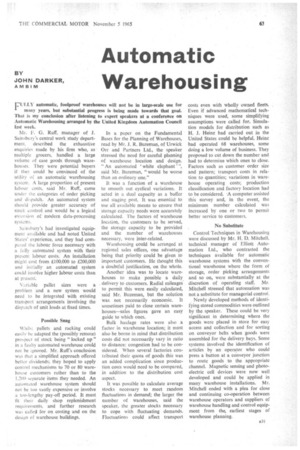Automatic Warehousing
Page 65

If you've noticed an error in this article please click here to report it so we can fix it.
BY JOHN DARKER,
AMBIIVI
FULLY automatic, foolproof warehouses will not be in large-scale use for many years, but substantial progress is being made towards that goal. That is my conclusion after listening to expert speakers at a conference on Automatic Warehousing arranged by the United Kingdom Automation Council last week.
Mr. F. G. Ruff, manager of J. Sainsbury's central work study department, described the exhaustive enquiries made by his firm who, as multiple grocers, handled a large volume of case goods through warehouses. They were potential buyers if they could be convinced of the utility of an automatic warehousing system. A large proportion of present labour costs, said Mr. Ruff, came under the categories of order picking and dispatch. An automated system should provide greater accuracy of stock control and would be a logical extension of modern data-processing systems.
Sainsbury's had investigated equipment available and had noted United States' experience, and they had compared the labour force necessary with a fully automated system with their present labour costs. An installation might cost from £100,000 to £200,000 and initially an automated system could involve higher labour costs than at present.
Variable pallet sizes were a problem and a new system would need to be integrated with existing transport arrangements involving the dispatch of unit loads at fixed times.
Possible Snag
Whilst pallets and racking could easily he adapted the (possibly remote) prospect of stock being "locked up" in a faulty automated warehouse could not be ignored. Mr. Ruff's conclusion was that a simplified approach offered better dividends; they hoped to apply control mechanisms to 70 or 80 warehouse customers rather than to the l,200 separate items they needed. An automated warehouse system should not be too vastly expensive or involve a too-lengthy pay-off period. It must fit their daily shop replenishment requirements, and further research was called for on costing and on the desiun of warehouse buildings. In a paper on the Fundamental Bases for the Planning of Warehouses, read by Mr. J. R. Bozeman, of Urwick Orr and Partners Ltd., the speaker stressed the need for careful planning of warehouse location and design. "An automated 'white elephant' ", said Mr. Bozeman, "would be worse than an ordinary one."
It was a function of a warehouse to smooth out cyclical variations. It acted in a dual capacity as a buffer and staging post. It was essential to use all available means to ensure that storage capacity needs were accurately calculated. The factors of warehouse location, the customers to be served, the storage capacity to be provided and the number of warehouses necessary, were inter-related.
Warehousing could be arranged at regional sales offices, one advantage being that priority could be given to important customers. He thought this a doubtful justification, on the whole.
Another idea was to locate warehouses to make possible a daily. „ delivery to customers. Radial mileages to permit this were easily calculated, said Mr. Bozeman, but the solution was not necessarily economic. It sometimes paid to close certain warehouses—sales figures gave an easy guide to which ones.
Bulk haulage rates were also a factor in warehouse location; it must also be borne in mind that distribution costs did not necessarily vary in ratio to distance; congestion had to be considered, When several factories contributed their quota of goods this was an added complication since production costs would need to be compared, in addition to the distribution cost aspect.
It was possible to calculate average stocks necessary to meet random fluctuations in demand; the larger the number of warehouses, said the speaker, the greater stocks necessary to cope with fluctuating demands. Fluctuations could affect transport costs even with wholly owned fleets. Even if advanced mathematical techniques were used, some simplifying assumptions were called for. Simulation models for distribution such as H. J. Heinz had carried out in the United States could be helpful. Heinz had operated 68 warehouses, some doing a low volume of business. They proposed to cut down the number and had to determine which ones to close. Factors such as customer order size and pattern; transport costs in relation to quantities; variations in warehouse operating costs; production classification and factory location had to be considered. -A computer assisted this survey and, in the event, the minimum number calculated was increased by one or two to permit better service to customers.
No Substitute
Control Techniques in Warehousing were discussed by Mr. H. D. Mitchell, technical manager of Elliott Automation Ltd., who contrasted the techniques available for automatic warehouse systems with the conventional warehouse where the form of storage, order picking arrangements and so on, were substantially at the discretion of operating staff. Mr. Mitchell stressed that automation was not a substitute for managerial control.
Newly developed methods of identifying stored commodities were outlined by the speaker. These could be very significant in determining where the goods were placed in store for easy access and collection and for sorting on conveyor belts when goods were assembled for the delivery bays. Some systems involved the identification of articles by an operator who could press a button at a conveyor junction to route goods to the appropriate channel. Magnetic sensing and photoelectric cell devices were now well developed and could be applied in many warehouse installations. Mr. Mitchell ended with a plea for close and continuing co-operation between warehouse operators and suppliers of warehouse handling and control equipment from the, earliest stages of warehouse planning.




















































































































